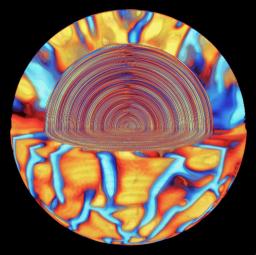We are studying how stars work, the Sun first of all. We have deepened our knowledge of the Sun via helioseismology observations (discovery of global gravity modes with SOHO-GOLF (Garcia et al., Science 316, 1591 (2007)) and large magneto-hydrodynamics simulations on massively parallel computers (Brun et al. ApJ, 742, 79). The link between the Sun and other stars has been made through our participation in the exploitation of asteroseismology data obtained by the Kepler and Corot missions and state-of-the art simulations of stellar dynamos, activity and cycles (Augustson et al. 2013, 777, 153). We are developing the field of interactions (magnetic, tidal forces) between the stars and their environment (planet, wind, circumstellar envelope; Mathis et al. 2013, Lect. Notes. Physics, 861, 255; Pinto et al. 2011, ApJ, 737, 72).
The Saturn system serves as a detailed laboratory to study the gravitational processes at work in planet formation and circumstellar discs. Exploiting Cassini observations, we have developed an original theory of formation and evolution of Saturn satellites (Charnoz et al. Nature 465, 752 (2010)), which only works if the tidal force between Saturn and its satellite is 10 times higher than usually considered. Confirmation of the strong tidal force has been obtained through precise astrometric measurements of the motion of Saturn satellites (Lainey et al., ApJ 752, 19 (2012)). Such a strong tidal force can be reproduce by the new model of Remus et al. (A&A 541, A165 (2012)).
see the homepages : - "Laboratory Dynamics of Stars and their Environment"
- "Star and Planet Formation Laboratory"




